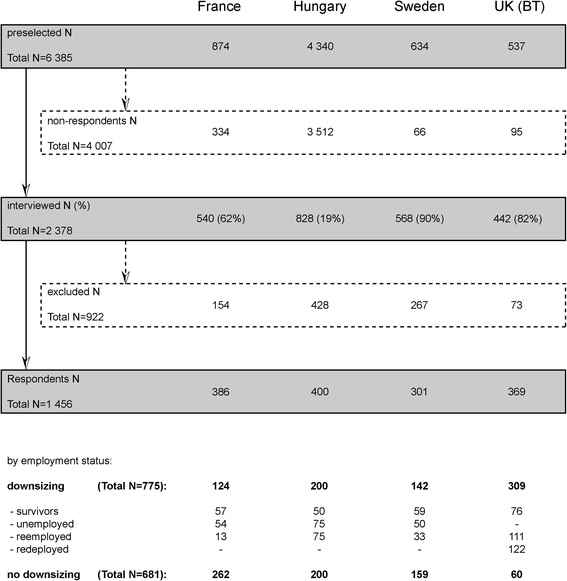Risk of psychological ill health and methods of organisational downsizing: a cross-sectional survey in four European countries
- PMID: 28962605
- PMCID: PMC5622469
- DOI: 10.1186/s12889-017-4789-3
Risk of psychological ill health and methods of organisational downsizing: a cross-sectional survey in four European countries
Abstract
Background: The manner in which organizational downsizing is implemented can make a substantial difference as to whether the exposed workers will suffer from psychological ill health. Surprisingly, little research has directly investigated this issue. We examined the likelihood of psychological ill health associated with strategic and reactive downsizing.
Methods: A cross-sectional survey included 1456 respondents from France, Sweden, Hungary and the United Kingdom: 681 employees in stable workplaces (reference group) and 775 workers from downsized companies. Reactive downsizing was exemplified by the exposures to compulsory redundancies of medium to large scale resulting in job loss or surviving a layoff while staying employed in downsized organizations. The workforce exposed to strategic downsizing was represented by surplus employees who were internally redeployed and supported through their career change process within a policy context of "no compulsory redundancy". Symptoms of anxiety, depression and emotional exhaustion were assessed in telephone interviews with brief subscales from Hospital Anxiety Scale (HADS-A), Hopkins Symptom Checklist (SCL-CD6) and Maslach Burnout Inventory (MBI-GS). Data were analyzed using logistic regression.
Results: We observed no increased risk of psychological ill health in the case of strategic downsizing. The number of significant associations with psychological ill health was the largest for the large-scale reactive downsizing: surviving a layoff was consistently associated with all three outcome measures; returning to work after the job loss experience was related to anxiety and depression, while persons still unemployed at interview had elevated odds of anxiety. After reactive medium-scale downsizing, unemployment at interview was the only exposure associated with anxiety and depression.
Conclusions: The manner in which organizational downsizing is implemented can be important for the psychological wellbeing of workers. If downsizing is unavoidable, it should be achieved strategically. Greater attention is needed to employment and health policies supporting the workers after reactive downsizing.
Keywords: Cross-sectional survey; European countries; Psychological ill health; Reactive downsizing; Returning to work; Strategic downsizing; Surviving a layoff; Unemployment.
Conflict of interest statement
Ethics approval and consent to participate
All participants of the Restructuring Survey received an invitation letter with information about the study and provided their written informed consent in accordance with the Helsinki declaration. The national parts of the survey were approved by the respective research ethics committees: Tudományos Kutatás Etikai Bizottság in Budapest (the Scientific Research Ethics Committee, Ref.no: TUKEB 187/2008), the Regional Research Ethics Committee in Stockholm (Ref.no: 2009/337–32), the Research Ethics Committee of Kingston University in London (approval from January 22, 2010). The French survey received approval from the “Comité Consultatif sur le Traitement de l’Information en matière de Recherches dans le domaine de la Santé (CCTIRS)” of the Ministry of Research (March 12, 2009) and the legal authorization of the “Commission Nationale de l’Informatique et des Libertés (CNIL)” on April 23, 2009.
Consent for publication
Not applicable.
Competing interests
The authors declare that they have no competing interests.
Publisher’s Note
Springer Nature remains neutral with regard to jurisdictional claims in published maps and institutional affiliations.
Figures
Similar articles
-
Depressive symptoms as a cause and effect of job loss in men and women: evidence in the context of organisational downsizing from the Swedish Longitudinal Occupational Survey of Health.BMC Public Health. 2015 Oct 12;15:1045. doi: 10.1186/s12889-015-2377-y. BMC Public Health. 2015. PMID: 26458894 Free PMC article.
-
Organizational downsizing and depressive symptoms in the European recession: the experience of workers in France, Hungary, Sweden and the United kingdom.PLoS One. 2014 May 19;9(5):e97063. doi: 10.1371/journal.pone.0097063. eCollection 2014. PLoS One. 2014. PMID: 24841779 Free PMC article.
-
Financial crisis and collapsed banks: psychological distress and work related factors among surviving employees--a nation-wide study.Am J Ind Med. 2013 Sep;56(9):1095-106. doi: 10.1002/ajim.22210. Epub 2013 Jun 24. Am J Ind Med. 2013. PMID: 23797952
-
Layoff survivor sickness: how to cope when you do not lose your job.J Perianesth Nurs. 1998 Aug;13(4):236-8. doi: 10.1016/s1089-9472(98)80020-8. J Perianesth Nurs. 1998. PMID: 9814294 Review.
-
A Scoping Review of the Impact of Downsizing on Survivors.J Nurs Adm. 2021 Jun 1;51(6):329-333. doi: 10.1097/NNA.0000000000001022. J Nurs Adm. 2021. PMID: 33989238
Cited by
-
Impact of the COVID-19 pandemic on student' sleep patterns, sexual activity, screen use, and food intake: A global survey.PLoS One. 2022 Jan 28;17(1):e0262617. doi: 10.1371/journal.pone.0262617. eCollection 2022. PLoS One. 2022. PMID: 35089943 Free PMC article.
-
Dual impact of organisational change on subsequent exit from work unit and sickness absence: a longitudinal study among public healthcare employees.Occup Environ Med. 2018 Jul;75(7):479-485. doi: 10.1136/oemed-2017-104865. Epub 2018 May 14. Occup Environ Med. 2018. PMID: 29760173 Free PMC article.
-
A Cross-Sectional Analysis of Employment Returns to Education and Health Status in China: Moderating Role of Gender.Front Psychol. 2021 Feb 26;12:638599. doi: 10.3389/fpsyg.2021.638599. eCollection 2021. Front Psychol. 2021. PMID: 33716907 Free PMC article.
-
Organisational Justice, Burnout, and Engagement in University Students: A Comparison between Stressful Aspects of Labour and University Organisation.Int J Environ Res Public Health. 2018 Sep 26;15(10):2116. doi: 10.3390/ijerph15102116. Int J Environ Res Public Health. 2018. PMID: 30261618 Free PMC article.
-
Association Between Organizational Downsizing and Depressive Symptoms Among Korean Workers: A Cross-sectional Analysis.Saf Health Work. 2024 Sep;15(3):352-359. doi: 10.1016/j.shaw.2024.06.005. Epub 2024 Jul 4. Saf Health Work. 2024. PMID: 39309291 Free PMC article.
References
-
- Noer D. Healing the wounds: overcoming the trauma of layoffs and revitalizing downsized organizations. San Francisco: Jossey-Bass; 1993.
-
- Mandal B, Roe B. Job loss, retirement and the mental health of older Americans. J Ment Health Policy Econ. 2008;11(4):167–176. - PubMed
MeSH terms
LinkOut - more resources
Full Text Sources
Other Literature Sources
Medical
Research Materials
Miscellaneous


